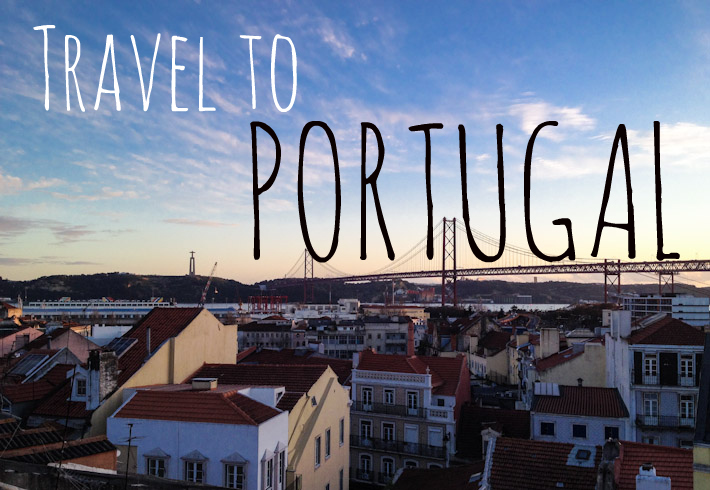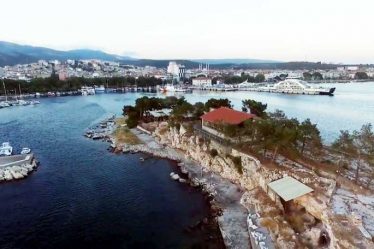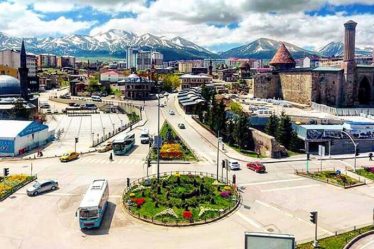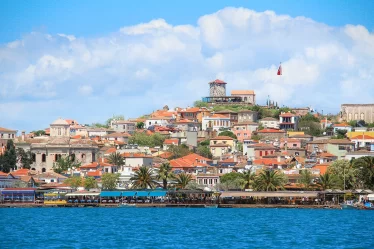
Portugal is one of the interesting countries to see in Europe with its medieval castles, golden beaches, stone villages adorned with wonderful churches and indispensable cities that offer extraordinary tastes and rich cultures. Portugal, located on the Iberian Peninsula in the southwest of Europe , is surrounded by Spain to the north and east, and the Atlantic Ocean to the west.
It is known as ‘where the land ends and the sea begins’, as the legendary poet Luis Vaz de Camoes said in the 16th century. Life in the country, which is Europe’s western border to the sea, is intertwined with modern technology and traditional fishing-farming style, making the world smaller, more integrated and more complex.

Portugal is like a distant relative of Europe. It is a country of colors, located at the southwestern tip of the continent, next to Spain, and facing the Atlantic. Portugal’s contribution to the new age of world exploration is quite high. Portugal, once a mighty maritime kingdom, once dominated all trade ships to Africa, South America and the East.
This sea-smelling country, which has hosted many civilizations in its history, experienced its heyday in the 15th and 16th centuries with its overseas growth and colonization. Portugal, which carried its culture to many parts of the world with geographical discoveries, continued its influence in a wide geography from Brazil to the Philippines between the 15th and 16th centuries.
So much so that the borders of the empire spread from Africa and Asia to America towards the middle of the 16th century and expanded to include Brazil in its territory. However, King of Spain II. When Felippe seized the throne, Portugal entered under the rule of Spain until 1690; The decline that started with this peaked in the 17th and 18th centuries, with the loss of colonies.
King II. Although a republic was declared after Manuel’s abdication in 1920, a new regime based on dictatorship was established with Antonio de Oliveira Salazar becoming prime minister in 1932. With the April 1974 Revolution, also known as the Carnation Revolution, the Salazar administration was overthrown. To understand the spirit of Portugal, it is necessary to get to know this people who made a non-violent revolution, which is rare in world history.
And even that is enough to admire this country where there are trees on every street, moss flows from the city walls and balconies are decorated with flowers. Since this revolution, which started with the playing of Paulo de Carvalho’s piece E depoi do adeus , representing Portugal in the Eurovision Song Contest on April 24, 1974, people are still singing for this in the streets, as if the music had penetrated the soul of the streets at that moment.

The 2000 film Capitães de Abril (April Revolution) about this revolution says a lot about this country and its people. The most beautiful month of carnations is April, and during the revolution, carnations are attached to the barrels of guns and tanks in the Lisbon Flower Market located in the city center; This is where the revolution takes its name.
In the southwest of Europe, the country on the Iberian Peninsula also has autonomous administrations of the Azores and Madeira archipelagos.
Portugal Attractions
Portugal, sandwiched between Spain and the Atlantic Ocean, has a very impressive nature waiting to be discovered. Don’t be fooled by the fact that Portugal is a small country. This small country has a very vibrant and vibrant culture, history, and beautiful nature. It has rich and innovative cities, traditional villages, stunning beaches, countryside and numerous UNESCO world heritage sites.
Portugal offers almost every facility a visitor could ask for. Portugal’s geographical features start from the vineyards and lush mountains in the north, continue to the medieval towns with farm fields in the middle, and end with magnificent beaches around the Algarve on the southern coastline.
Cities such as Coimbra, Guimaraes, Braga and Evora are some of the cities that have managed to preserve their medieval spirit very well. The Azores and Madeira archipelagos belonging to Portugal and located in the Atlantic Ocean are also known for their flower gardens and lush nature. When we look beyond the hillside beaches of the Algarve, we see pastures where Portuguese shepherds graze their sheep and cities with a very rich culture.
Portugal Attractions
- Lisbon
- Sintra
- Porto
- Obidos
- Coimbra
- Aveiro
- Evora
- Algarve
- Madeira
- Azores
- Fatima
1. Lisbon

The capital of Portugal, Lisbon , holds the title of being the largest city in the country. Like Istanbul, Lisbon also has large bridges connecting the two coasts, and the city is built on seven hills. With its lively and energetic stone masonry streets, funicular routes, world-famous museums, legendary cuisine, shopping and nightlife, it is a city that would not be worth seeing.
The city, which has a wonderful climate on the shores of the Atlantic Ocean, attracts hundreds of thousands of tourists every year, as well as its pleasing streets, wonderful shops, Gothic cathedrals, impressive bridges and colorful lifestyle, as well as the indispensable passion of the country.
In Alfama, the oldest residential area of the city, in the area dominated by Moroccan-style architecture, stone streets and St. George’s Castle. The best way to get to know Lisbon is to take the famous No. 28 Tram and explore the city.
2. Sintra

Located at the foot of Mount Sintra, the city is within a daily commute distance from the capital and boasts verdant hills, stunning villas dotted throughout the city, luxury resorts, castles and famous palaces such as Pena’s Palace. Built in the mid-1800s, the fantastic castle commemorating the German Neuschwanstein used to serve the Portuguese royal family. A woodland adorned with exotic trees, plants and flowers surrounds Pena’s Palace.
3. Porto

With its narrow cobblestone streets, wide squares with a wide variety of scents, riverbanks where sounds mingle, and lots of colorful people of different types, Porto is Portugal’s most unique city.
Located among the hills overlooking the Douro River in the north of Portugal, Porto is famous for its world-famous wines. At the very heart of the city, Ribeira, with its pedestrian-only area, is both fascinating and has a great atmosphere with live music, cafes, restaurants and street vendors. The most famous place of the region is the iron bridge called Ponte Dom Luis that connects Porto to Vila Nova de Gaia .
Right next to Porto, you can visit the caves where Portugal’s most famous drinks are found and crown your trip after a great tasting experience.
4. Obidos

Obidos , which is famous for its narrow streets surrounded by flowers and city walls and its cherry liqueur ; Portugal’s third largest city, Bom Jesus do Monte Cathedral , which can be reached by cable car, and Braga , another religious center, are among the places to join the route during your Portugal trip.
Located on a hill in the west of Portugal , Obidos is a city to see with its magnificent walls, magnificent medieval castle and historical Obidos Square. Exploring its labyrinth-like streets on foot is the best choice. It is a city that fascinates visitors with its crowded squares, beautiful shops and white houses with colorful flowers on the windows. Although the castle’s huge gate, towers and battlements now serve as a very luxurious hotel, it has not lost anything of its splendor.
5. Coimbra

Coimbra , a small and very charming town, is home to many historical treasures, magnificent gardens, and the most outstanding examples of fado music on the banks of the Mondego River in Central Portugal. The best thing to do in Coimbra is to get lost among all these historical sites, cathedrals and monasteries. Each of the monasteries, including the sarcophagus of Queen Isabella, is uniquely beautiful. The libraries of the University of Coimbra and especially the Joanina Library are worth seeing in Coimbra.
6. Aveiro

Hugging the Atlantic Coast of central Portugal, Aveiro is also called the “Venice of Portugal” for its wonderful canals and canal bridges. While the colorful gondolas and boats roam between the canals, you can visit the historical parts of the city and enjoy the magnificent beaches. Aveiro’s cuisine is quite famous, you will definitely find something to suit your taste. Places to see in Aveiro include the Aveiro Cathedral, the Sao Gonçalinho Chapel, and the Convento de Jesus.
7. Evora

One of Portugal’s best preserved medieval towns. Evora is surrounded by walls and has a Roman and Gothic architecture with winding stone paths. Evora may be small, but it’s more than enough to attract tourists in the south of Portugal. Evora, which has a history of almost 2000 years, was once an important city that shone under the Roman Empire.
Today, as the capital of the Alentejo region, it hosts more than 4000 historical buildings with its very well-preserved historical city center. Evora Cathedral, one of the most important Gothic structures of 13th century Portugal, is worth seeing. Not far from the city is the complex of Europe’s largest prehistoric monuments.
8. Algarve

Algarve , located in the southernmost part of the country , is one of the best places to see in Portugal with its warm Mediterranean climate, beautiful beaches, interesting towns, historical sites and delicious food.
Lush olive groves, traditional whitewashed villages, a magnificent beach nestled at the foot of the hills offer a feast for the eyes. Faro is the capital of this region and Lagos nightlife seeker is the place to go. Famous for its orange groves and red sandstone castle is Silves . Tavira, a very elegant town with its Renaissance monuments, bridges and castles, is among the places to see in the Algarve.
9. Madeira

Known as the “Floating Garden of the Atlantic”, Madeira is a very fertile oasis in the Atlantic Ocean between North Africa and Portugal. It gives the right to this view with its lush vegetation, flower gardens and wines. Must-see places include the Orchid Garden and Laurissilva forest.
Funchal , the capital and largest city of Madeira , boasts an extraordinary ocean view with its tree-lined promenade alongside historic churches, castles, resorts and restaurants.
10. Azores

About 1,500 km off Lisbon, the Azores Archipelago , famous for its world-famous whale watching tours, consists of 9 volcanic islands in the Atlantic Ocean. The islands offer examples of a unique life with their hot spring waters, quiet seaside towns and the unique characteristics of each island. Sao Miguel is the largest island of the Azores and is also known as the “Green Island”. Pico is where Portugal’s highest mountain is located.
11. Fatima

Portugal is a Catholic country and they are very devoted to their religion. For this reason, cross points and religious symbols in certain parts of the country attract a lot of attention. Fatima , located on the way from Lisbon to Porto, is one of the most important places of cross for Catholics. The city of Fatima has also become a source of pride for the Portuguese, after the miracles believed to have happened after 3 shepherd children claimed to have seen the Virgin Mary.
Fatima , located 1 hour away from Lisbon, is a pilgrimage site that is considered very sacred for the Christian world and hosts 5 million people every year. You can be sure that the Batalha Palace, which is very close to Fatima, the most beautiful example of medieval architecture, will leave a deep place in your memory.
Portuguese cuisine
Portuguese cuisine is inspired by the sea; They bring everything that comes from the sea to their tables with rice and bread. The most consumed fish is salted cod, which they call Bacalhau , and they cook this fish in many different ways, with names such as Pasteis de Bacalhau (Fish Cake) and Bacalhau a Bras (Grilled Bacalao Fish).
Sardines, which are much larger than we know because they are ocean fish, are an indispensable part of Portugal’s tables. Green soup made with potatoes and cabbage (caldo verde), fish stew (calderirada de peize), shark soup (popa de cacao) and francesinha, a ham and hot dog sandwich served with melted cheese poured on top and a special sauce, are among the delicacies you should not come without eating. .
Before starting the meal, olive oil and delicious breads are placed on the table; Bread, which is usually made with sourdough, turns heads with its smell. Restaurants generally serve as small family businesses in a unique way.
Eating out is quite cheap in Portugal, a person can get enough with a dessert and a drink for an average of 15-20 Euros. Of course, we should not forget the calorie-dense desserts that emit delicious smells and are generally made with dough.
The most famous of these is their national dessert, Pasteis de Belem , which has its origins in a very old Patisserie in Lisbon’s Belem district . If you want to buy this dessert, which is known with the same name as Pasteis de Belem Patisserie, which dates back to 1837, you have to wait in a long queue every hour of the day, but it is worth the taste.
Another flavor that comes to mind when Portugal is mentioned is of course the wine, which draws its strength from the Douro Valley in Porto, but shows itself with vineyards all over the country.
While the alcohol rate in standard wines is around 11-12%, the alcohol rate in port wine is generally 20%; this makes it a drinker that needs attention rather than a table wine. It is possible to find a variety of delicious wines in every restaurant you enter, with prices varying from 1 Euro to 25 Euro per glass.
The cork oak tree, which is used to make wine corks, mostly grows on Portuguese soil. 55% of the world’s production is met by Portugal, and it has a large share in the country’s economy. This share also shows itself in the souvenir sector with bags, nevales, wristbands and other objects.

when to go
Portugal, a country with year-round sunshine, is especially wonderful in summer, and June to September is one of the best times to go. The temperature is a few degrees below or above 30 degrees. Since July and especially August are holiday months in Portugal, the density and crowd is very high in the coastal areas. You should not forget to make your reservation early for this peak season when prices are also skyrocketing.
If you want to hike or explore the mountains, we recommend that you come in May or October, as it can be a bit hot during this period. The most suitable months for options such as walking around the city and exploring archaeological sites are the months at the door or exit of winter or autumn.
The most rain falls in the winter months from November to March. The central part of Portugal is perfect for visiting during the colder months, as the hot and sharp sun shines through even in winter. A temperate climate prevails throughout the year, especially on the south coast. On the other hand, in the north, the weather can be quite cold, and snow can often be seen in mountainous areas, especially in the interior.
You can fly to Lisbon directly with Turkish Airlines and Portuguese Airlines, or by connecting with other airlines .


